How Chip Seal Paving Works – An In-Depth Step-by-Step Guide
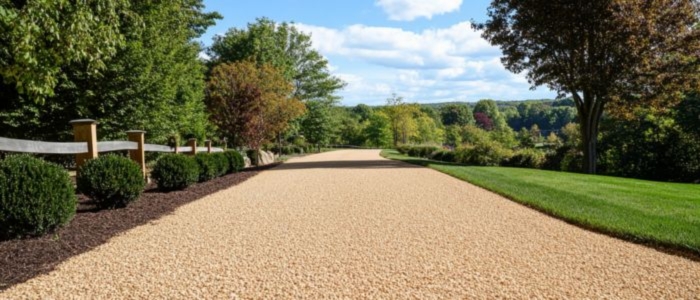
Chip Seal paving is a surface treatment that combines liquid asphalt and aggregate (small stones) to create a durable protective coating. This process enhances pavement strength, prevents cracking, and extends the lifespan of roads and driveways, offering a cost-effective maintenance solution.
So, How Does Chip Seal Paving Work?
Chip Seal paving works by first applying a layer of hot liquid asphalt to the surface of the pavement. After that, small stones (aggregate) are spread over the asphalt and compacted, allowing the asphalt to bind with the stones. This creates a tough, durable surface that protects the pavement, improves its strength, and helps to prevent cracks. The result is a cost-effective way to extend the life of your pavement.
Learn the exact steps involved in how chip seal paving works: a step-by-step guide, what to expect during installation, and whether this option is right for your property.
Step-by-Step Process of Chip Seal Paving
Chip seal paving is a multi-step process that requires precision to ensure a durable and long-lasting surface. Here’s a breakdown of each step:
Step 1: Surface Preparation
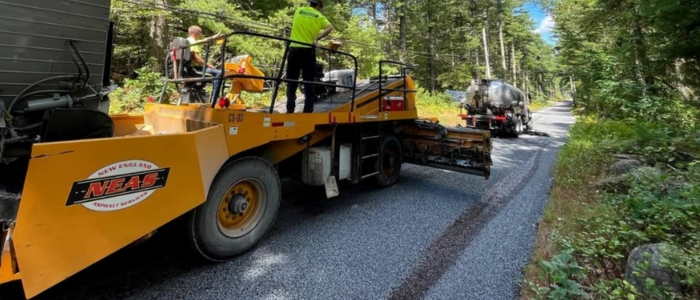
Surface preparation is the most important first step in the chip seal paving process. Before any new material can be applied, the existing pavement must be thoroughly cleaned and repaired.
First, the pavement is swept or washed to remove any dirt, dust, leaves, and other debris that may have accumulated on the surface. This cleaning step is essential because any debris left behind can prevent the binder from properly bonding with the pavement, potentially causing the new layer to peel or wear prematurely.
Next, any cracks, potholes, or surface imperfections are addressed. Small cracks are typically filled with an appropriate crack filler, ensuring that the surface is smooth and continuous. If there are larger holes or damaged areas, these may require more extensive repairs, such as patching with fresh asphalt.
Repairing these imperfections not only helps with the bond but also ensures that the chip seal layer is applied evenly across the entire surface, providing a smooth and uniform finish.
In addition, the surface must be dry before the binder is applied. Proper surface preparation is critical to the overall success of the chip seal process.
Step 2: Application of Binder
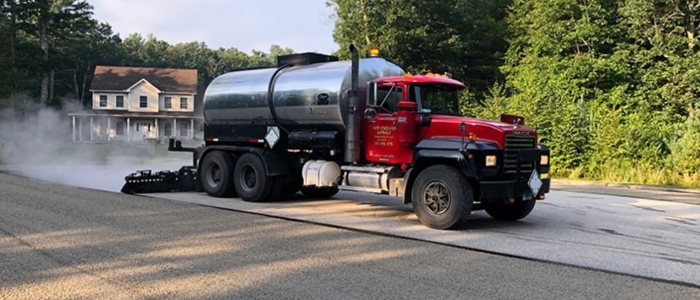
Step two in how chip seal paving works: a step-by-step guide focuses on application. The application of the binder forms the foundation for the aggregate to adhere to the surface. This step involves spraying a hot asphalt emulsion or binder evenly across the prepared pavement. The binder essentially acts as the “glue” that holds the crushed stone or gravel (aggregate) in place, ensuring a secure and durable surface.
The binder used in chip seal paving is a specially formulated asphalt emulsion that is heated to a specific temperature before being applied. The heat helps the binder flow smoothly, ensuring it covers the entire surface evenly and can penetrate any small cracks or pores in the pavement. This helps to create a strong bond between the old pavement and the new layer of material.
For optimal performance, the binder must be applied uniformly. Uniform application ensures that the aggregate will adhere properly to every part of the surface, preventing any weak spots or areas where the aggregate may not stick, which could lead to premature wear or peeling.
The thickness of the binder layer is carefully controlled to ensure it is just the right amount to securely hold the aggregate without excess. Too little binder may not provide a strong enough bond, while too much could lead to an uneven surface or a slippery texture.
Timing
One of the key factors for a successful application of how chip seal paving works: a step-by-step guide is the timing. The binder needs to be applied while it’s still hot and fluid, as this allows it to properly bond with the aggregate and set correctly as it cools.
This process also ensures that the binder remains flexible, which is important for accommodating temperature fluctuations and the natural expansion and contraction of the pavement over time.
By applying the binder uniformly and at the right temperature, the chip seal process forms a strong, long-lasting bond that supports the aggregate, creating a stable, weather-resistant surface.
Proper binder application is essential for ensuring the durability and effectiveness of the chip seal over the long term, protecting the underlying pavement and enhancing its lifespan.
Step 3: Aggregate Spreading
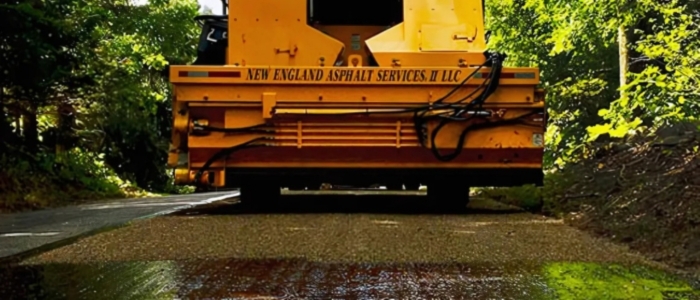
Step three in how chip seal paving works: a step-by-step guide is all about spreading aggregate. Once the binder has been evenly applied to the surface, the next step in the chip seal process is the spreading of the aggregate.
This is a crucial phase, as the aggregate plays a significant role in both the appearance and performance of the finished surface. The aggregate, typically made up of crushed stone or gravel, is spread evenly across the binder to create the final layer that will provide texture, durability, and protection.
The choice of aggregate size and type is incredibly important in determining the final outcome of the chip seal. The aggregate must be evenly distributed across the entire surface to ensure consistency in both the finish and durability of the surface.
Specialized equipment, such as chip spreaders, is used to apply the aggregate in a controlled and uniform manner, ensuring that the stones are spread evenly without overloading certain areas or leaving gaps.
Thinking About a New Chip Seal Driveway?
Request a Free Quote
Our team is ready to help you create a durable, beautiful surface that stands the test of time. Contact us today to learn more.
Size and Type of Aggregate
The size of the aggregate directly affects the texture and appearance of the finished surface when understanding how chip seal paving works: a step-by-step guide. Larger stones tend to create a more textured, rougher surface that provides additional grip and durability, making it ideal for roads or driveways that will endure heavy traffic.
The rougher texture also helps with water runoff, reducing the potential for pooling or erosion over time. On the other hand, smaller stones can give a smoother, more polished finish, which may be desirable for driveways or areas where aesthetics and a more refined appearance are a priority.
In addition to size, the type of aggregate used can influence the longevity and functionality of the chip seal. Harder, more durable stones—such as granite or basalt—are often selected for their resistance to wear and erosion, especially in high-traffic areas.
Softer stones may be more cost-effective but can wear down more quickly, reducing the lifespan of the chip seal. The right aggregate selection balances durability, aesthetics, and performance, depending on the specific needs of the property.
Ensuring Proper Coverage
Once the binder is fully applied and the aggregate is spread, it’s important to ensure that the aggregate is adequately embedded into the binder. This is typically achieved during the compaction step, but initial coverage is vital to the overall success of the project.
In understanding how chip seal paving works: a step-by-step guide, the aggregate should be spread evenly to avoid uneven wear, weak spots, or an inconsistent texture that may affect both the appearance and functionality of the surface.
Aesthetic and Practical Balance
Choosing the right aggregate ensures a balance between aesthetic appeal and the practical needs of the surface. For example, larger stones may be better suited for high-traffic or utility-focused surfaces, while smaller stones can be used to create a more refined, smoother appearance for residential driveways or pathways.
The color and type of the aggregate can also impact the visual appeal of the chip seal, with different shades of stone offering a variety of looks, from natural earth tones to lighter, more contemporary finishes.
Ultimately, the successful spreading of the aggregate plays a crucial role in the overall performance of the chip seal, directly affecting the surface’s durability, safety, and aesthetic appeal.
It is important to know how chip seal paving works: a step-by-step guide because by selecting the right aggregate and ensuring it is evenly spread, the result is a long-lasting, functional, and visually appealing paved surface.
Step 4: Compaction
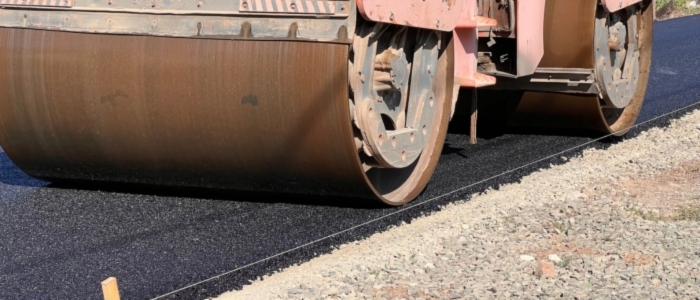
After the aggregate has been evenly spread across the binder, the next critical step in the chip seal process is compaction. This fourth step in how chip seal paving works: a step-by-step guide involves the use of heavy rollers to press the crushed stone or gravel firmly into the binder, ensuring that the aggregate becomes securely embedded.
Compaction is essential to the overall strength, durability, and longevity of the chip seal surface, and it plays a vital role in creating a smooth, interlocked finish that can withstand the stresses of traffic, weather, and time.
Why Compaction Matters
The primary purpose of compaction is to ensure that the aggregate is properly pressed into the binder, creating a solid bond between the two materials. Without adequate compaction, the aggregate may sit loosely on the surface, leading to uneven wear, stone displacement, or premature degradation of the surface.
Proper compaction ensures that the binder fully encapsulates the aggregate, locking it in place to form a stable, uniform surface.
This step in how chip seal paving works: a step-by-step guide also increases the surface density, making it more resistant to damage from heavy traffic or adverse weather conditions. When the aggregate is properly compacted, it creates an interlocking system that enhances the overall strength of the chip seal, helping it resist cracks, potholes, and other forms of damage.
How Compaction is Achieved
Compaction is typically achieved using a roller, a large piece of equipment that applies pressure to the surface to push the aggregate into the binder. There are different types of rollers used depending on the size of the project and the desired finish.
Most commonly, smooth drum rollers or pneumatic rollers are used. These rollers have a heavy weight that, when applied to the surface, creates the necessary pressure to embed the stones into the binder without disturbing the uniformity of the surface.
The rolling process is done in multiple passes, with the roller moving back and forth across the surface in overlapping patterns to ensure complete and even compaction. In some cases, the number of passes may vary depending on the size of the aggregate and the type of surface being treated.
To better comprehend how chip seal paving works: a step-by-step guide, it is important to know about the compaction process. The compaction process is carefully monitored to avoid over-compacting, which could lead to an overly smooth surface that lacks texture, or under-compacting, which could result in loose stones.
Benefits of Proper Compaction
Proper compaction aids in durability, safety, and bonding, as well as creating a smooth, sleek finish.
- Enhanced Durability: Compaction is key to creating a strong, durable chip seal that can resist wear from vehicles, weather, and environmental factors. A well-compacted surface is less likely to suffer from loose stones or cracking over time, ensuring a longer lifespan for the pavement.
- Improved Safety: The compaction process helps ensure that the surface is even, reducing the risk of bumps, uneven wear, or loose stones that can create hazards for vehicles and pedestrians. It also helps enhance the surface’s skid resistance, providing a safer driving experience.
- Better Bond Between Binder and Aggregate: The pressure from the roller forces the binder to fully saturate the aggregate, ensuring a tight bond. This not only improves the adhesion between the binder and the stones but also prevents the stones from shifting or dislodging under heavy traffic.
- Smooth, Interlocked Finish: After compaction, the aggregate forms an interlocked structure that creates a solid, unified surface. This finish is important for both the appearance and functionality of the chip seal, as it enhances both the visual appeal and performance of the surface.
Timing and Temperature Considerations
Compaction is most effective when the binder is still hot, as this ensures that it remains fluid and can properly bond with the aggregate. If the binder has cooled too much before compaction, it may not effectively hold the aggregate in place, which could result in an unstable surface.
Therefore, timing is essential in this step to ensure that the compaction process is done while the binder is at its optimal temperature, allowing it to retain its adhesive properties.
Compaction and Weather Resistance
A well-compacted chip seal surface is more resistant to the effects of weather, including water infiltration, freezing, and thawing. By securely embedding the aggregate into the binder, the surface becomes less susceptible to erosion or damage from environmental factors.
This added resistance makes chip seal an excellent option for areas with varying weather conditions, from hot summers to freezing winters.
In summary, the compaction step is crucial in how chip seal paving works: a step-by-step guide for ensuring that the aggregate is securely embedded in the binder, resulting in a smooth, durable, and long-lasting surface.
Proper compaction not only enhances the overall appearance of the chip seal but also ensures that the surface will withstand traffic, weather, and time, offering lasting protection for your pavement.
Step 5: Sweeping and Final Touches
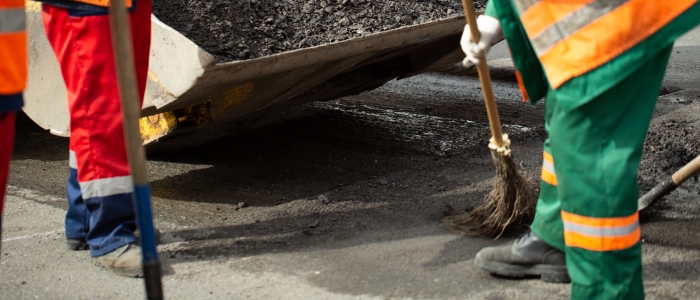
The final phase of the chip seal paving process in how chip seal paving works: a step-by-step guide involves sweeping off any excess loose stones and applying optional finishing touches to ensure the surface is both functional and visually appealing.
This crucial step in how chip seal paving works: a step-by-step guide helps complete the project, leaving behind a clean, smooth, and durable surface that is ready for use.
Sweeping Off Excess Loose Stones
After the compaction process, there will inevitably be some loose stones that haven’t fully embedded into the binder. These stones must be carefully swept off the surface to ensure that only the stones securely compacted into the binder remain.
Using specialized equipment, such as a mechanical sweeper, the excess stones are removed, leaving behind a neat and consistent surface. This step helps to avoid any stones from becoming dislodged over time, which could lead to damage or uneven wear. It also ensures a safer surface for vehicles and pedestrians, as loose stones could pose a hazard, particularly for drivers who may encounter unexpected debris.
Once the sweeping is complete, the surface is left with an even, tightly compacted layer of aggregate that is firmly bonded to the binder.
This ensures that the chip seal is stable, long-lasting, and visually smooth, with minimal risk of loose material.
Thinking About a New Chip Seal Driveway?
Request a Free Quote
Our team is ready to help you create a durable, beautiful surface that stands the test of time. Contact us today to learn more.
Optional Fog Seal Application
While the sweeping process is the last major task, there is often an additional step in how chip seal paving works: a step-by-step guide that can be applied for extra protection and aesthetic enhancement: the fog seal.
A fog seal is a light, thin coating of asphalt emulsion that is sprayed over the surface of the newly paved chip seal. The purpose of the fog seal is twofold.
- Enhanced Protection: The fog seal serves as an additional layer of protection for the chip seal surface. It helps to lock in the aggregate and binder, providing extra stability and further preventing any stones from loosening.
This added protection can extend the lifespan of the chip seal, especially in areas that experience harsh weather conditions, heavy traffic, or high levels of moisture.
The fog seal also improves the surface’s resistance to wear, erosion, and water infiltration, helping to maintain the integrity of the pavement over time.
- Aesthetic Appeal: Beyond its protective benefits, the fog seal enhances the visual appeal of the surface. The light coating of asphalt emulsion gives the chip seal a darker, richer appearance, creating a more polished, uniform look.
It also helps to even out the texture of the aggregate, reducing any variations in color or roughness, and provides a glossy finish that enhances the overall aesthetic of the paved area.
The fog seal can be particularly beneficial for driveways, pathways, or other residential and commercial areas where curb appeal is important.
Drying and Curing Time

In understanding how chip seal paving works: a step-by-step guide, it is also important to let the seal dry and cure after the fog seal has been applied.
This typically takes a few hours, depending on weather conditions, but it’s important to give the surface enough time to fully set before allowing traffic or pedestrians to use the newly paved area.
During this time, the fog seal bonds with the aggregate and binder, creating a smooth, uniform surface that’s both functional and visually appealing.
Final Inspection and Quality Check
Once the fog seal has dried and any remaining loose stones have been cleared, a final inspection is performed to ensure that the chip seal surface meets all quality standards.
This includes checking for evenness, stability, and proper bonding between the aggregate, binder, and fog seal. The project is also evaluated to confirm that the surface is free of any potential hazards, such as exposed or uneven stones.
This final quality check ensures that the chip seal will provide optimal performance, aesthetics, and safety for years to come.
Final Touches
The sweeping and final touches step is essential for ensuring that the chip seal surface is both functional and visually appealing to gaining a full idea of how chip seal paving works: a step-by-step guide. By removing loose stones and applying an optional fog seal, you not only enhance the durability and longevity of the surface but also achieve a clean, polished look that can improve the overall appearance of your property.
This final step adds an extra layer of protection, ensuring that the chip seal will withstand the test of time and provide a smooth, safe surface for years to come.
By following these steps in how chip seal paving works: a step-by-step guide, chip seal paving creates a long-lasting, cost-effective surface that is ideal for extending the life of your existing pavement.
Contact NEAS today to learn more about how chip seal paving can benefit your property and get started on your next paving project!
Benefits of Chip Seal Paving

Chip seal paving offers a range of advantages that make it a popular choice for both residential and commercial properties. From its durability to its charm, here are the key benefits of opting for chip seal paving:
Durability
Chip seal paving is known for its impressive durability. The process seals cracks in the existing pavement, preventing water penetration, which is one of the main causes of pavement deterioration.
By creating a weather-resistant surface, chip seal helps protect the underlying pavement from further damage caused by moisture, freeze-thaw cycles, and heavy traffic.
This added layer of protection can significantly extend the lifespan of your pavement, reducing the need for costly repairs in the future.
Improved Traction
The textured surface of chip seal paving provides improved traction, making it a safer option, particularly for roads and driveways that experience regular traffic.
The crushed stone or gravel aggregate creates a rough, skid-resistant surface, which enhances grip for vehicles, reducing the likelihood of slipping, especially during rainy or icy conditions.
This makes chip seal an excellent choice for areas where safety is a top priority, such as steep driveways or roadways prone to weather-related hazards.
Low Maintenance
Another benefit of chip seal paving is its low maintenance requirements. Once installed, chip seal surfaces require minimal upkeep compared to other paving options.
Regular sweeping to remove loose stones and periodic inspections to check for cracks or wear are typically all that is needed to maintain the surface.
Additionally, since the surface is durable and resistant to water infiltration, there is less risk of developing potholes or other significant damage, which means fewer repairs are needed over time.
Thinking About a New Chip Seal Driveway?
Request a Free Quote
Our team is ready to help you create a durable, beautiful surface that stands the test of time. Contact us today to learn more.
Fast Application
One of the reasons so many people want to know more about how chip seal paving works: a step-by-step guide is because of its fast application. Chip seal paving is also known for its quick application process. The installation can typically be completed much faster than full asphalt replacement, allowing roads and driveways to reopen sooner.
In some cases, the surface can be used within a few hours after the installation is finished, minimizing downtime and disruption to your property or traffic flow. This makes chip seal a convenient option for areas that need to be paved quickly or for properties where access is a concern.
In summary, chip seal paving offers a range of benefits, including cost savings, enhanced durability, improved traction, low maintenance, and a fast application process.
These advantages make it a smart choice for property owners looking to improve their pavement without the high costs and extended timelines associated with more traditional paving methods.
Advanced Applications and Variations
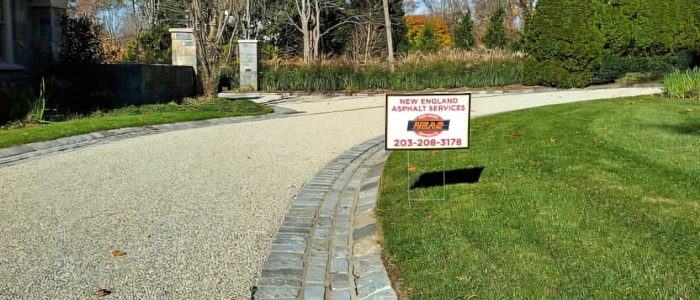
While chip seal paving is highly effective on its own, there are advanced applications and variations that offer additional benefits when extra durability, a smoother finish, or further crack prevention is required. Here are some of the more advanced options for chip seal:
Double/Triple Chip Seal
For areas that experience high traffic or extreme weather conditions, a double or triple chip seal can be applied to increase the durability of the surface. This process involves applying additional layers of binder and aggregate, each layer compacted to form a thicker, stronger surface.
A double chip seal uses two layers of binder and aggregate, while a triple chip seal uses three. These added layers provide increased protection against wear and tear, making them ideal for roads or driveways that need to withstand heavy vehicles, constant use, or severe weather conditions.
The multiple layers create a more resilient surface that can handle the stress of high traffic volumes and frequent exposure to the elements.
Cape Seal
A Cape Seal is an advanced variation of chip seal that combines the chip seal process with a slurry seal on top. After the chip seal is applied and compacted, a slurry seal—essentially a thin, smooth layer of asphalt emulsion mixed with fine aggregate—is spread over the surface.
This creates a smoother, more uniform finish than standard chip seal, while still providing the durability and weather resistance of the original chip seal.
The Cape Seal option is ideal for areas where a smoother surface is desired without sacrificing the durability and low maintenance benefits how chip seal paving works: a step-by-step guide.
It’s commonly used for roads and residential driveways where aesthetics and performance both matter.
SAMI (Stress Absorbing Membrane Interlayer)
The SAMI is a specialized application used in conjunction with asphalt overlays to reduce cracking and extend the life of existing pavement. SAMI is a layer of modified asphalt emulsion that is applied before an asphalt overlay is placed.
It acts as a stress-absorbing membrane that helps to bridge existing cracks and prevent them from propagating into the new asphalt layer. SAMI is particularly beneficial in areas with extensive cracking or where structural issues may exist beneath the surface.
This application can significantly improve the longevity of an asphalt overlay, providing extra protection against cracking, which ultimately reduces maintenance and repair costs.
These advanced chip seal variations provide property owners with additional flexibility to meet specific needs—whether it’s for enhanced durability, a smoother finish, or more effective crack prevention.
Choosing the right variation depends on the level of traffic, environmental conditions, and desired performance of the surface.
Common Challenges and How to Avoid Them

While chip seal paving offers many benefits, it’s important to be aware of potential challenges that can arise in how chip seal paving works: a step-by-step guide.
Understanding these challenges and knowing how to prevent or address them can help ensure the longevity and effectiveness of your chip seal surface.
Here are some of the most common issues and how to avoid them:
Loose Aggregate: How to Prevent Early Stone Loss
One of the most common issues with chip seal surfaces is loose aggregate, where stones begin to dislodge from the binder, especially shortly after installation.
This can be frustrating and detract from the surface’s smoothness, safety, and durability.
Loose aggregate is typically caused by improper compaction or insufficient binder application, which means the stones are not securely embedded.
How to Avoid It
To prevent loose aggregate, it’s essential to ensure that proper compaction is carried out after the aggregate is spread.
The use of heavy rollers is key to pressing the aggregate into the binder, creating a stable, interlocked surface.
Additionally, applying the correct amount of binder ensures the aggregate has enough adhesive material to hold it in place.
Finally, sweeping off excess loose stones after installation and allowing proper curing time can further prevent stones from coming loose.
In some cases, a fog seal can be applied as a final touch to help further lock the stones into place and create a more uniform surface.
Surface Bleeding: What Causes It and How to Fix It
Surface bleeding occurs when the asphalt binder rises to the surface of the chip seal, creating a sticky, shiny, or oily appearance.
This often happens when too much binder is used or when the weather conditions are too hot during application. Excess binder on the surface can also make the aggregate less secure and lead to problems such as loose stones or a slippery surface.
How to Fix It
To prevent surface bleeding, it’s crucial to apply the correct amount of binder and to carefully control the temperature during application.
If bleeding does occur, the surface can often be corrected by applying additional aggregate to absorb the excess binder.
In some cases, the application of a sand blotter (fine sand spread over the surface) can help absorb excess asphalt and reduce the sticky appearance.
If necessary, a light application of a fog seal can also help improve the surface appearance and add an extra layer of protection.
Weather Dependence: Why Temperature and Timing Matter

Weather plays a significant role in the chip seal process, and timing is crucial for achieving the best results.
In order to know just how chip seal paving works: a step-by-step guide, it is important to know when to apply certain steps of the process. The binder needs to be applied while it is still hot and fluid to ensure proper adhesion to the surface and the aggregate.
Additionally, temperature fluctuations, especially extreme heat or cold, can affect the binder’s ability to bond properly, leading to issues like poor adhesion or premature wear.
Thinking About a New Chip Seal Driveway?
Request a Free Quote
Our team is ready to help you create a durable, beautiful surface that stands the test of time. Contact us today to learn more.
How to Avoid Weather Issues
To ensure the best results, chip seal should be applied during optimal weather conditions, typically in warmer months when temperatures are consistently above 60°F (15°C).
The asphalt binder should be heated to the manufacturer’s recommended temperature range before application to ensure it flows properly.
It’s also important to avoid applying chip seal during rainy or extremely humid conditions, as moisture can interfere with the binder’s ability to adhere to the surface.
Timing is critical—paving should be done when the surface is dry, and weather forecasts should be checked to avoid unexpected weather changes that could disrupt the installation.
By carefully managing weather conditions, ensuring proper binder application, and addressing any surface bleeding or loose aggregate, property owners can significantly reduce the likelihood of these common challenges and enjoy a durable, long-lasting chip seal surface.
Longevity and Maintenance

Chip seal paving is a versatile and effective solution, but it may not be the right fit for every project. Understanding how chip seal paving works: a step-by-step guide can help property owners make the most of this cost-effective option. Here are a few scenarios where chip seal paving is an ideal choice:
Residential Driveways
Chip seal is an excellent choice for residential driveways, particularly for properties that require a durable, weather-resistant surface but may not justify the higher cost of full asphalt paving.
Its textured surface enhances traction, which can be important for driveways that are steep or located in areas with frequent rain or snow.
Additionally, chip seal provides an aesthetically pleasing finish with a variety of aggregate types and colors available to match the property’s look.
Low to Moderate Traffic Areas
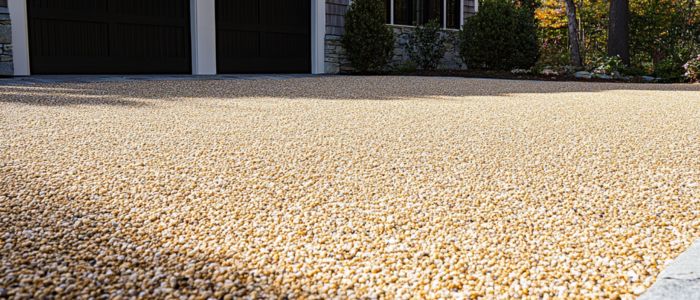
Chip seal is perfect for areas with light to moderate traffic, such as rural roads, private driveways, and smaller parking lots.
The surface provides adequate durability and wear resistance for these areas without the need for the extensive investment required for a full asphalt overlay.
It can effectively handle everyday use while still maintaining its integrity and appearance for many years.
Pavement Restoration
For properties with existing pavement that’s still structurally sound but showing signs of wear, chip seal offers an excellent restoration solution.
It can be used to refresh and protect an existing surface by sealing cracks, preventing water penetration, and extending the life of the pavement.
Chip seal is an ideal option for rejuvenating roads, driveways, and parking lots that are not yet in need of a full replacement but would benefit from added protection.
Rural Roads and Highways
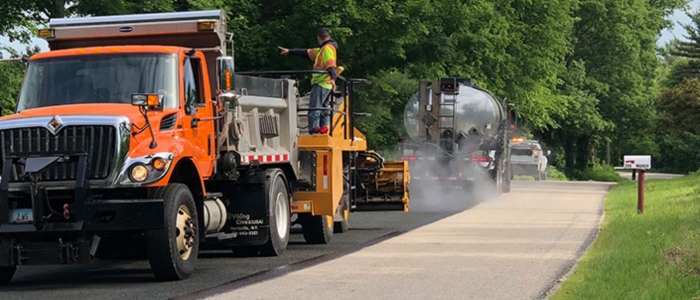
Chip seal is widely used on rural roads and highways, where heavy traffic volumes are not as high, but the road still requires durability and protection against the elements.
It provides an effective, long-lasting surface that helps prevent deterioration and extends the lifespan of the road without requiring the extensive infrastructure of full asphalt or concrete paving.
It’s a particularly popular choice in areas with variable weather conditions, as chip seal helps protect roads from water damage, freezing, and thawing.
Chip seal paving is the right choice when durability, cost-effectiveness, and quick installation are priorities.
It is especially well-suited for residential driveways, low-traffic areas, budget-conscious property owners, pavement restoration projects, and rural roads.
By understanding its advantages and ideal use in how chip seal paving works: a step-by-step guide, property owners can make an informed decision about whether chip seal is the best solution for their paving needs.
FAQS
Yes, chip seal can be applied over existing pavement, provided the surface is in good condition. The old pavement must be clean, free of debris, and any cracks or damage should be repaired before application. Chip seal works by bonding to the existing surface and adding a layer of protection, which helps extend the life of the pavement.
Typically, chip seal surfaces can be driven on within a few hours after installation, depending on the weather and curing conditions. The binder needs to cool and set, and the surface should be free of loose stones. However, it’s important to avoid heavy traffic immediately after application to allow the surface to fully set and avoid dislodging the aggregate. Full curing may take a few days.
Chip seal is a versatile paving option suitable for a wide range of climates and traffic types, but it is most effective in areas with moderate to light traffic. It performs well in both hot and cold climates, providing weather resistance against freezing, thawing, and extreme heat. For heavy traffic areas, additional layers like double or triple chip seal may be necessary for added durability. It’s also a great choice for residential driveways, rural roads, and private parking lots.
Chip seal and asphalt have different advantages, and the choice between them depends on the specific needs of your project. Chip seal is a more cost-effective solution than full asphalt paving and is ideal for low to moderate traffic areas. While asphalt provides a smoother, more uniform surface, chip seal offers excellent durability and weather resistance with a more textured finish that provides added traction. For those on a budget or needing quick application, chip seal can be a great alternative to asphalt.
Chip seal can last anywhere from 5 to 10 years, depending on factors such as traffic volume, weather conditions, and the quality of the application. Regular maintenance, such as sweeping loose stones and addressing minor cracks, can extend the lifespan of the chip seal surface. In areas with low to moderate traffic, chip seal is an excellent long-term solution that provides protection and durability for many years.
Chip seal is generally much more affordable than full asphalt paving. The cost is lower because it uses existing pavement and is less labor-intensive compared to complete resurfacing with asphalt. It offers a cost-effective way to extend the life of your driveway or road without the high costs associated with asphalt or concrete. While prices can vary depending on the size of the area and other factors, chip seal remains one of the most budget-friendly paving options available.
Thinking About a New Chip Seal Driveway?
Request a Free Quote
Our team is ready to help you create a durable, beautiful surface that stands the test of time. Contact us today to learn more.
Conclusion
In conclusion, chip seal paving is a highly effective, cost-efficient solution for extending the lifespan of your pavement while offering excellent durability, traction, and weather resistance.
The process involves several key steps, from surface preparation to the application of binder and aggregate, ensuring a stable, long-lasting surface that can withstand the elements and traffic.
Whether you’re looking to enhance a residential driveway, refresh an existing road, or protect your pavement from the wear and tear of daily use, chip seal offers a practical and affordable option.
With its low maintenance requirements, quick application time, and ability to improve traction and durability, chip seal is an ideal choice for many paving needs.
Ready to get started on your paving project? Contact New England Asphalt Services (NEAS) today to learn more about how chip seal can benefit your property and receive a detailed estimate!



